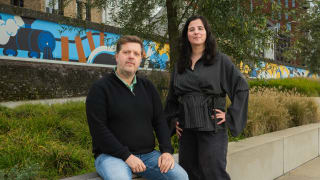Are AI, virtual reality, and blockchain the future of place marketing?
We’re at a technological crossroads. The rapid development of new technologies like generative AI and virtual reality are fundamentally altering the ways that we live, work, and play. However, what role do they play in place branding and place marketing? How can places leverage new technologies like artificial intelligence, virtual reality, and blockchain to promote and manage the reputation of your city, region, or nation more effectively?
“Any technology that gives people a greater sense of connection to place is going to be really important as placemaking shifts from being largely about physical interventions to much more of an experience driven discipline,” shared Mark Mobbs, Marketing Manager for Marketing Sheffield.
We reached out to our City Nation Place Global speakers to get their perspective on what role they think new technologies will play in the future of destination marketing and economic development, and to understand what opportunities there are to deepen people’s connection to your place.
Making sense of our vast oceans of data
Data underpins almost every activity within a place brand or marketing organisation. Success increasingly relies upon having access to the best insights and the most real-time data in order to remain competitive. However, place brand and marketing organisations are often resource-poor – and even the biggest organisations struggle to transform the vast amount of data available to them into actual insights.
Enter artificial intelligence and machine learning.
“If we look at data analysis, [these technologies] can help us in getting insights more efficiently and can be used in optimising campaigns, to target our audience better, and create personalised activities,” suggested Jolanda van Witzenburg, Head of Development at The Hague & Partners. “With the use of these insights, DMOs can get a better connection with their audience.”
Jean Scheltema, Chief Marketing & Innovation Officer at Wesgro, concurred, flagging media, popular search trends, and even the weather forecast as three different sources that could be plugged into an algorithm to better predict travel habits and to allow marketers to respond more effectively. Being able to process and visualise data more effectively, also creates new opportunities for economic development organisations to highlight their strengths.
“Estonia’s investment promotion agency used chatbots and e-advisors to keep investment flowing during the pandemic,” Jean went on to explain. “It subsequently introduced a standout tool: ComparEST. It’s an online tool letting foreign investors match up Estonia with other countries.” The tool blends AI, research, and advisor insights to give an overview of Estonia’s competitiveness – and it is also a clear demonstration of Estonia’s own digital credentials.
Capturing the attention of your audience
Once you’ve nailed your audience insights comes the need to grab their attention. “You constantly have to be thinking about the very top of the funnel, which is pure and simply getting people talking about your place,” explained Marketing Sheffield’s Mark Mobbs. “Whether it’s as simple as a Snapchat filter or as complex as an investment analysis dashboard, it can have merit in building your brand.”
There is an awful lot competing for your audience’s attention. Leveraging new technologies can be a really effective way of creating buzz around your place. Or perhaps it allows people to interact with your place in a new way. And according to Daniel Cavero, Head of Country Branding Office at PromPeru, “artificial intelligence (AI) and new technologies are playing an increasingly important role in destination and goods marketing, as it offers tools that help in the personalisation and automation of products and services… around the interests and motivations of the target audience.”
AI chatbots are increasingly able to provide custom itineraries and respond to basic queries from travellers and investors. By being better able to curate your proposition, you can showcase the areas in which you can deliver against the wants and needs of your customer.
Innovative uses of technology in place marketing
At City Nation Place, we’re fortunate to hear about a number of different ways that places are adopting smarter, more innovative approaches to capturing their audience’s attention. Here’s a selection of the strategies that have caught our eye:
- Augmented reality: Marketing Sheffield recently launched a new augmented reality art trail called ‘Look Up.’ The project helps to bring the city centre to life, celebrate the creativity of Sheffield’s residents and businesses, and encourage people to engage with the city on a deeper level.
- Virtual reality: In 2020, Helsinki used a digital replica of the city to host a virtual May Day celebration during lockdown. Now, the team at Helsinki Partners are working to use this technology to create opportunities for prospective travellers to get a first taste of Helsinki and inspire a future visit.
- Metaverse: Wesgro’s Jean Scheltema flagged the ways in which they’ve leveraged AI in recent campaigns for Cape Town and the Western Cape, including “building the Western Cape region of the Cape Karoo in the Metaverse via popular gaming platform, Roblox” and using “generative AI in asset creation and character design [and] using Midjourney for some of the animation making up the game.”
- NFTs and blockchain technology: The Slovenian Tourist Board created exclusive NFT (non-fungible tokens) digital souvenirs for a select group of media representatives. This ticket also functioned as a ticket to a unique, one-of-a-kind event – as well as being an innovative and press-worthy activation.
We’ll be unpacking the work of Sheffield, Helsinki, Slovenia, and also Thailand in more detail at City Nation Place Global 2023 this November 8-9th as part of our panel discussion on ‘People, places… and technology’.
The limitations and disadvantages of technology
Of course, every technology that you embrace also needs carefully looking at to understand the challenges and limitations that it brings as well. Cost is clearly always a factor, as is having the bandwidth across your team to kickstart it. However, there are bigger concerns as well to watch out for, such as data privacy or confidence in the ability of ChatGPT to deliver accurate information. Then there’s the validity of the data set that is fed into an algorithm and how this can replicate bias. And after all that, you might still find yourself holding an expensive bill once the hype has died down or a newer, better solution is on the market.
While these are still challenges that need addressing, it’s also clear that the genie is well and truly out of the bottle. As place brand and marketers, we need to adapt to new technologies or find ourselves left behind. That means that we also need to start upskilling our teams to be able to integrate these technologies into their work.
“It will not replace human activities. It might change jobs and requirements for a job [though], so continuous development of human skills is necessary,” answered The Hague & Partners’ Jolanda van Witzenburg. “As humans, we connect, feel, build relationships, and navigate towards a preferred direction – skills that cannot be overtaken by technology. I foresee a good combination of technology and human brains helping us in creating efficient marketing solutions.”
Join us at City Nation Place Global this November 8-9th to hear from a line-up of place leaders from around the world, including Jolanda van Witzenburg, The Hague & Partners, Mark Mobbs, Marketing Sheffield, Daniel Cavero, PromPeru, and Jean Scheltema, Wesgro. Check out the full agenda here.









